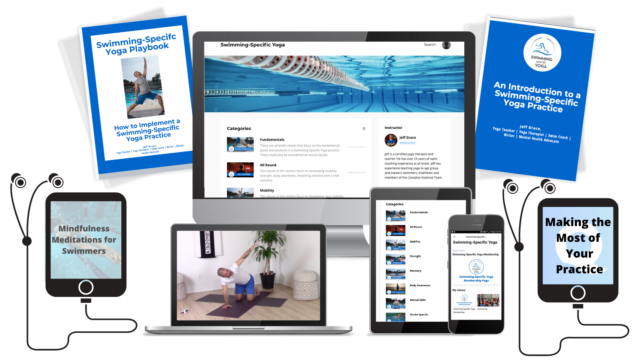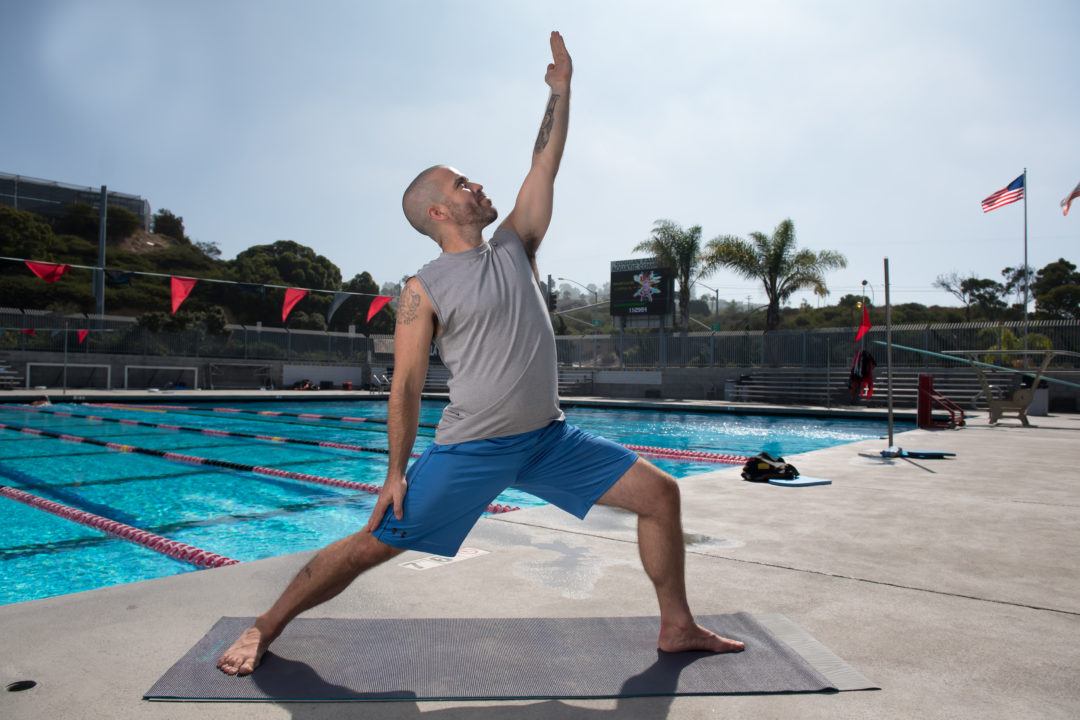Swimming-specific Yoga is designed as a functional practice. What does that mean?
Bernie Clark defines functional yoga as, “focusing on the intent of the postures rather than their appearance.” In our case the intention is to develop movement and mindfulness practices on the mat that give you an opportunity to improve your performance in the water.
Implementing a yoga practice designed for the unique needs of swimmers is an effective way to enhance your dry land training. Here are seven reasons why a swimming-specific yoga practice can help take your swimming to the next level.
1. Improves Mobility
Flexibility is one of the most common reasons swimmers and multi-sport athletes incorporate yoga into their training. Yoga can help increase range of motion, but the quest for greater flexibility isn’t always a productive one.
In an attempt to increase range of motion many athletes sacrifice stability. This leaves joints vulnerable to injury. It can also negatively affect the amount of the force that can be generated in this new range.
Therefore mobility rather than flexibility should be the focus.
INCREASED RANGE OF MOTION + STABILITY = MOBILITY
Mobility plays an important role in improving technical efficiency and swimming with greater ease.
2. Increases Strength
Strength is important to increase the ability to generate force, support technical development and reduce the risk of injury.
To move through the water effectively you need to have strength in different areas of your body as well as a strong connection throughout. This synergy is a key to ensuring you use your strength as efficiently as possible.
This connection is one of the reasons yoga is extremely effective in developing swimming-specific strength. The awareness a yoga practice for swimmers requires helps condition the targeted areas of the body as well as creating a stronger connection throughout.
3. Develops Body Awareness
Greater body awareness helps you move more effectively and efficiently.
A swimming-specific yoga practice develops a stronger connection to the present moment through movement and breath. That connection gives you an opportunity to listen to the body with greater clarity. This is one of the biggest differences between yoga and other training modalities.
You can apply this awareness to develop a greater understanding of how your body moves and the sensations you feel.
A few different ways yoga will help you increase your body awareness:
Balance
Balancing poses are an incredible way to develop body awareness. To stay stable you have to first listen to your body then make adjustments, sometimes smaller ones sometimes larger ones.
Listening to your body as well as understanding the adjustments required is the same process you use to make technical changes in the water.
Body Scanning
This is a foundational part of a swimming-specific yoga practice. In a body scan you move your awareness from head to toe noticing how you feel at specific points in the practice. You then revisit different poses and use subsequent body scans to build an understanding of how you are responding to different stimuli.
Identifying Differences
By understanding how poses feel differently on each side of the body you begin to understand how many small differences there are throughout the body both when moving and in stillness.
Does developing body awareness on land help you in the water? This is a very good question since you are working with several different factors including buoyancy and moving through a different fluid medium. From what I have observed when you take the time to learn how to listen to and understand your body it can benefit any activity.
4. Teaches You How to Work with Your Breath
Swimming is one of the only sports where you cannot breath at will. For this reason having the ability to work with the breath is one of the keys to success.
A swimming-specific yoga practice gives you an opportunity to breathe with intention.
By creating awareness of your natural breathing patterns and then manipulating them in different ways can teach you how to work with your breath more efficiently. Through this process you learn greater breath control.
In a swimming-specific yoga practice the breath connects the mind and the body. Co-ordinating breath and movement helps develop the ability to perform with greater ease.
Easy Speed
Effortless effort is a phrase you hear often in a yoga class. This is synonymous with Bill Sweetenham’s concept of easy speed. The legendary Australian swim coach describes this as applying both effort and ease to achieve a peak performance.
Combining easy speed and present moment awareness are key elements of a flow state or performing in the zone. Mihaly Csikszentmihalyi, the foremost expert on the subject says there is a strong connection between yoga and flow:
The similarities between Yoga and flow are extremely strong; in fact it makes sense to think of Yoga as a very thoroughly planned flow activity. Both try to achieve a joyous, self-forgetful involvement through concentration, which in turn is made possible by a discipline of the body.
5. Enhances Recovery
For swimmers to adapt to the stresses of training recovery is essential. Yoga is an effective modality to enhance the recovery process.
Four ways a swimming-specific yoga practice allows for this to occur are:
- Activating the Parasympathetic Nervous System
- Reducing Stress
- Releasing Muscle Tension
- Improving Sleep
Performing specific poses and working with your breath activates the parasympathetic nervous system. This is the side of your nervous system responsible for recovery and regeneration. You will also experience greater present moment awareness (mindfulness).
Mindfulness is the awareness that arises through paying attention on purpose in the present moment non-judgmentally (as defined by John Kabot-Zinn the creator of MBSR – mindfulness based stress reduction). The practice of mindfulness has been shown to reduce stress.
Combining restorative yoga poses and body scanning increases the awareness where you are holding tension. Once you have identified areas of tightness you can work with your breath to intentionally relax.
Activating the parasympathetic nervous system, reducing stress and releasing muscle tension can help you get to sleep with greater ease as well as improve the quality of your sleep.
6. Assists in Injury Prevention
Imbalances in your body can create vulnerability to injury. Although these are unique for each individual there are some imbalances that are commonly seen in swimmers.
A swimming-specific yoga practice can help create better balance in the body. Creating this balance is an important part of an injury prevention plan. Focusing on developing strength and mobility in specific area of the body will help to support joints that may be vulnerable to injury and rebalance the body.
Increasing body awareness will you give you a greater ability to listen to your body and understand how different movement patterns can create vulnerabilities.
7. Sharpens Mental Skills
Developing strong mental skills is an important part of achieving success in any sport. Even though this is an accepted fact many don’t take the time to focus on them. Both time restraints and the lack of practical ways to work on these skills makes it challenging.
An amazing thing about a yoga practice is it gives you the opportunity to work on mental skills while developing your physical abilities.
In his book Mental Skills for Competitive Swimmers world-renowned sports psychologist Dr. John Hogg lists several key skills needed to create an ideal performance state.
A swimming-specific yoga practice is a practical way to develop a number of those including:
- Self-Awareness
- Relaxation
- Self-Talk
- Visualization (Imagery)
- Attentional control
A yoga practice developed for swimmers develops all of these areas in very purposeful ways.
Mental Wellness
To excel in sport an athlete must be disciplined, focused, hard working, dedicated and continually look for new ways to improve performance. All of these characteristics can be seen as extremely positive and beneficial life skills. They are qualities that should be taught, promoted and embraced.
Although the positive qualities listed above can lead to great success they have the potential to create unhealthy ways of thinking. Many athletes have a hard time getting out of the performance mindset, which can lead to being overly self-critical as well as having a lack of self-acceptance and self-compassion.
Developing a mindful practice such as yoga and meditation can help you develop greater self-compassion and self-acceptance, which has the potential to greatly improve your mental health.
…
This Yoga for Swimmers article is brought to you by Swimming-Specific Yoga the world’s top resource for online yoga classes and content designed for swimmers and multi-sport athletes.
…
Until June 24th Swimming-Specific Yoga is running a Dive into Swimming-Specific Yoga offer.
For $49.99 you will receive:
- One year subscription to the Swimming-Specific Yoga membership platform – access to over 100 yoga classes ranging from 10-45 minutes in length with one new class being added to the library each week
- An Introduction to a Swimming-Specific Yoga ebook
- The Swimming-Specific Yoga Playbook on How to Implement a Swimming-Specific Yoga Practice
- Three Mindfulness Meditations for Swimmers created by Leslie Tomlinson of H2Om Yoga Therapeutics
- A three part audio series on How to Make the Most of Your Practice with Tom Barton of Q Swim
Go to swimmingspecificyoga.com to take advantage of this offer.


If you haven’t hit a shavastna pose properly then are you even really living?
GREAT ARTICLE! Excellent introduction to this particular form of “cross training” -> particilarly important for those of use in the geriatric end of the age groupings. THANK YOU, JEFF.